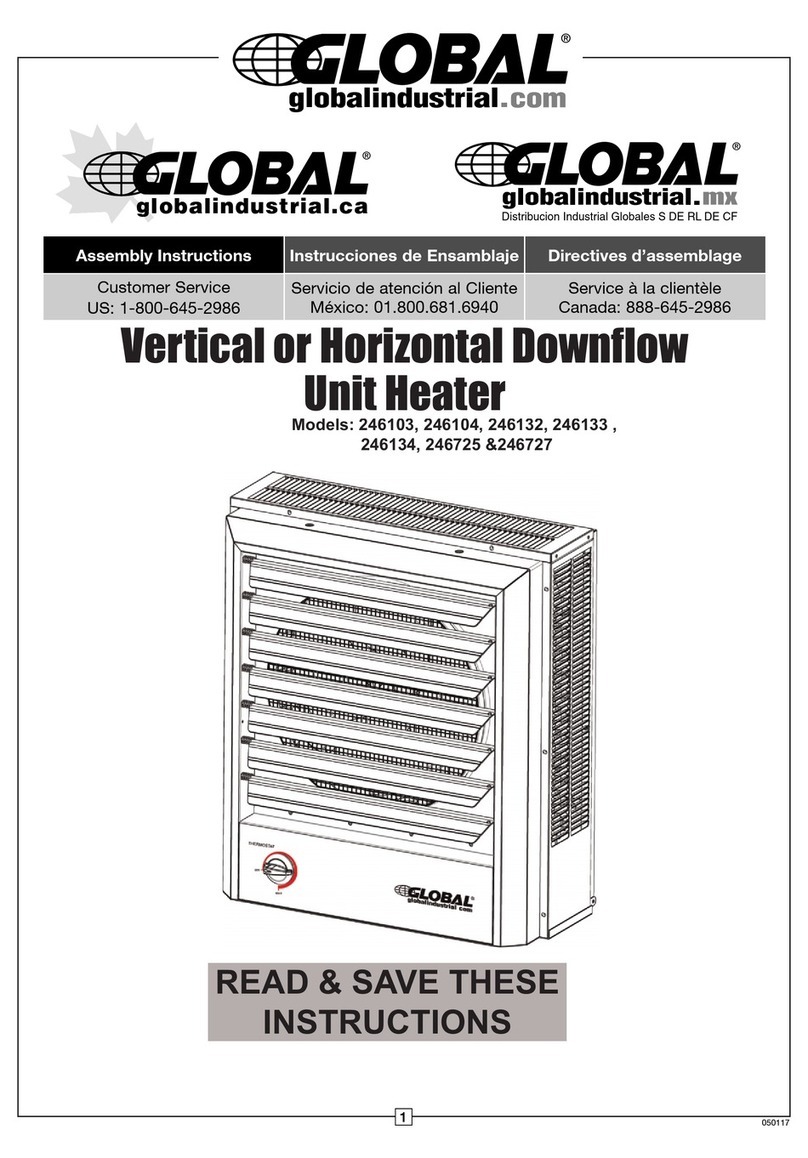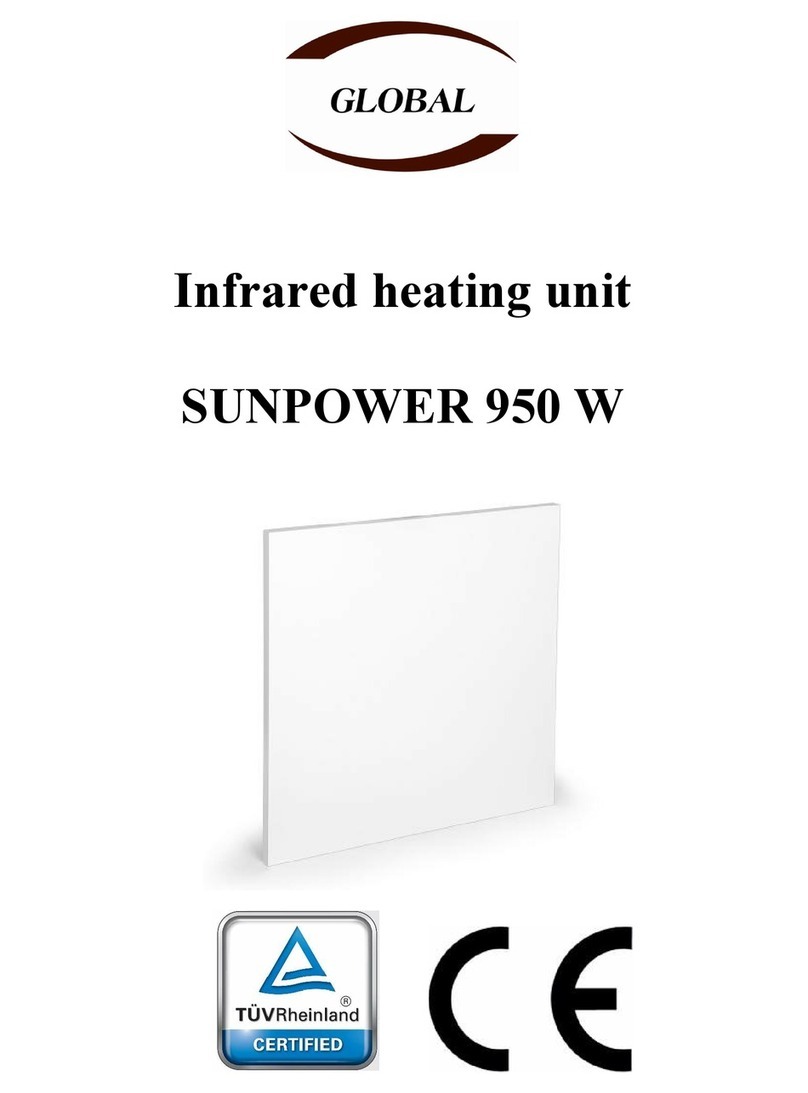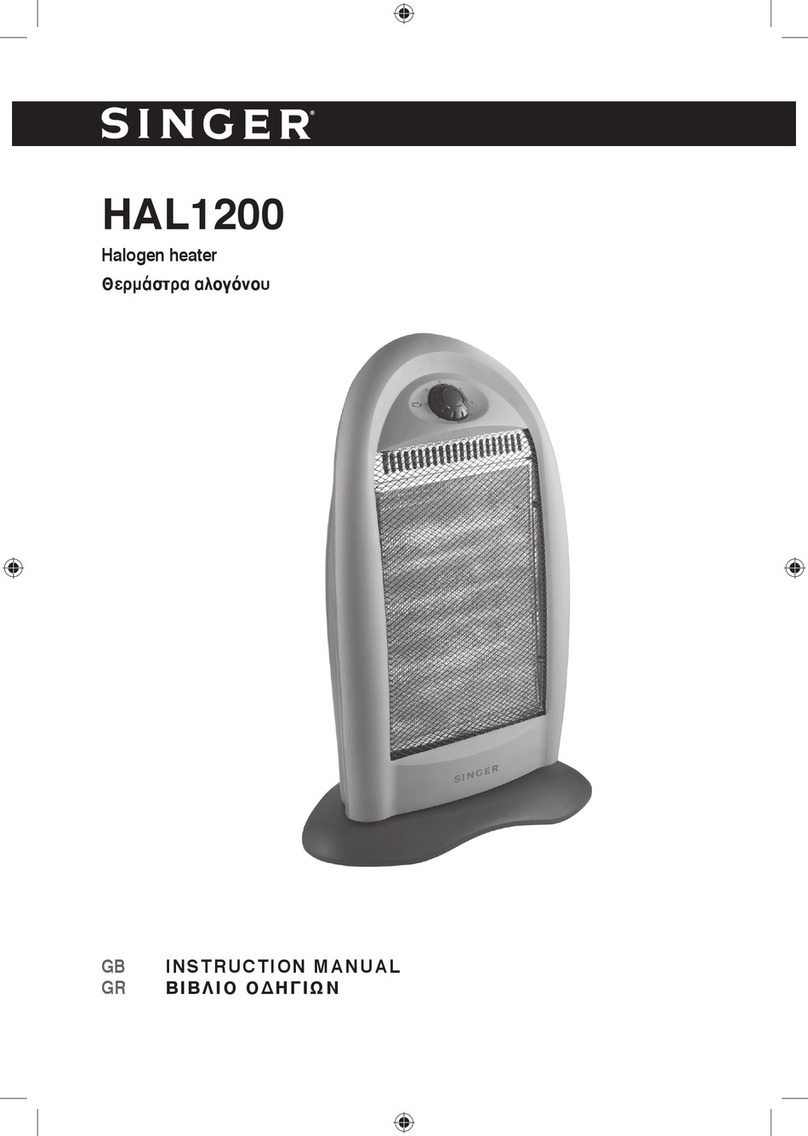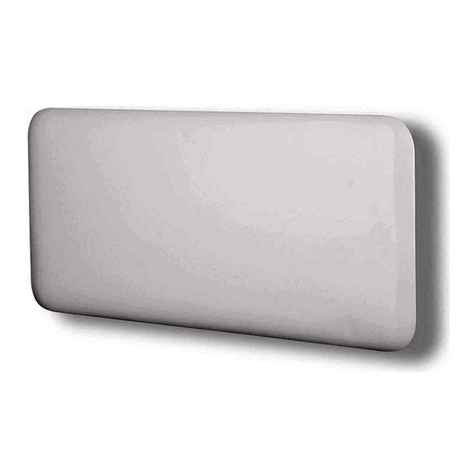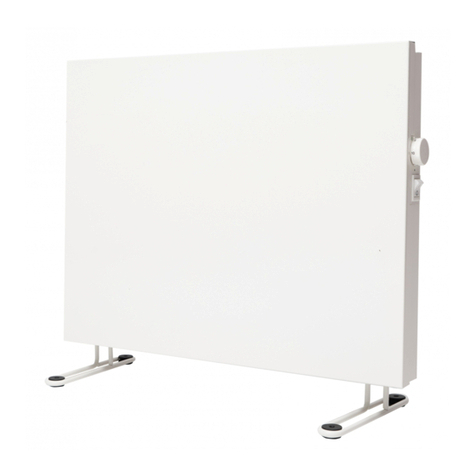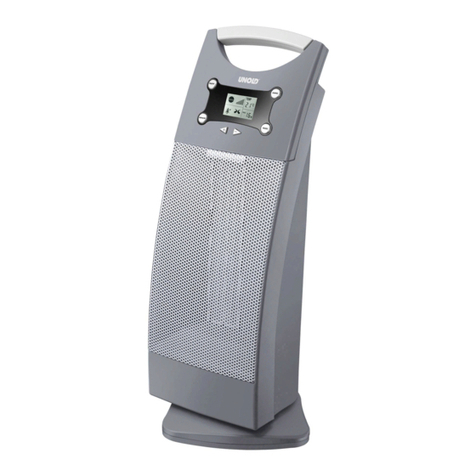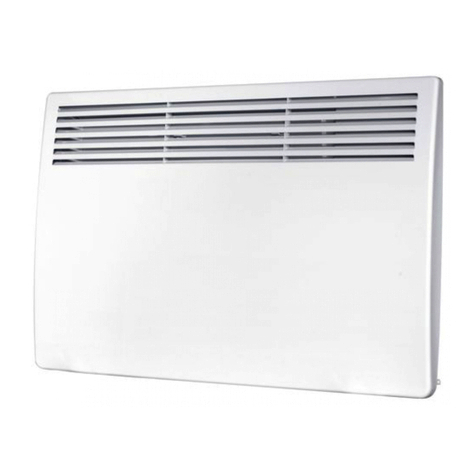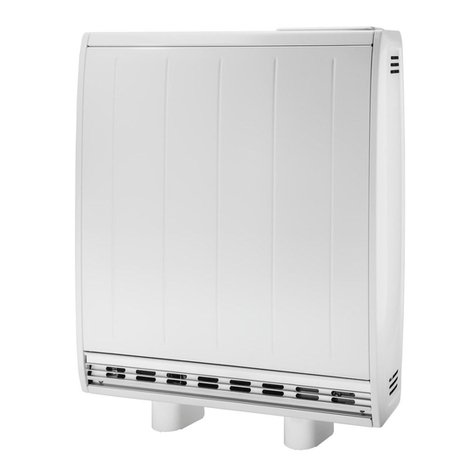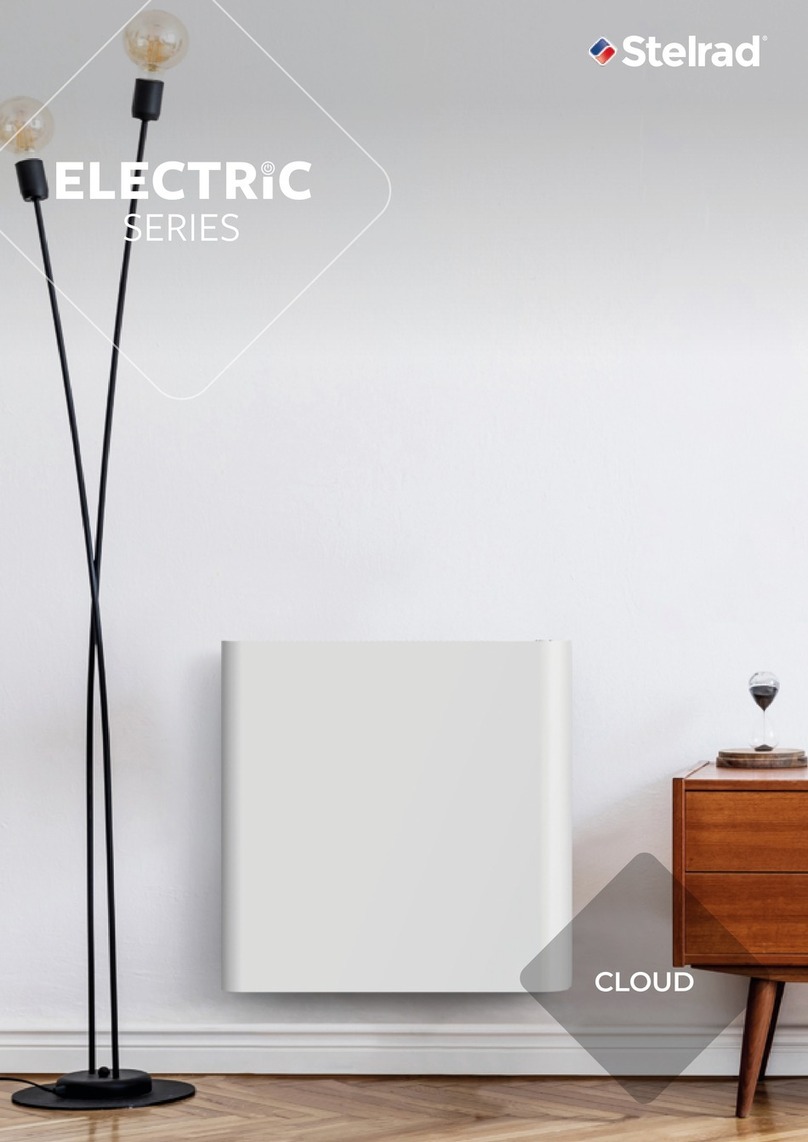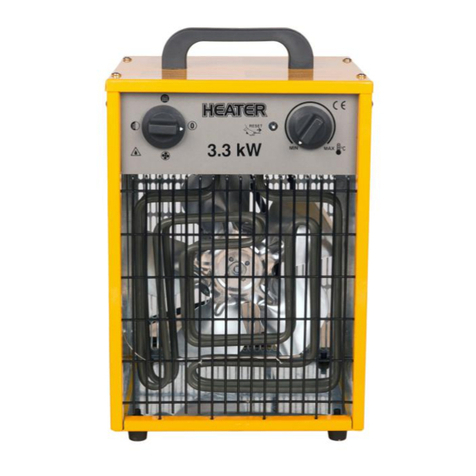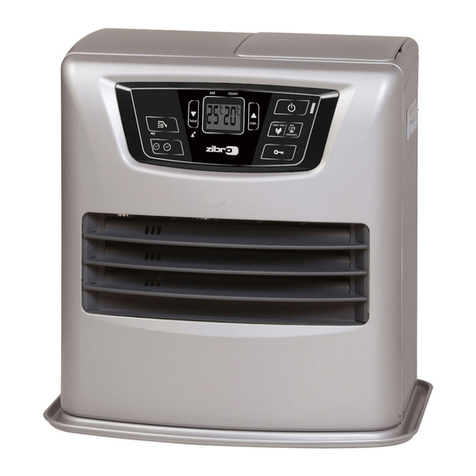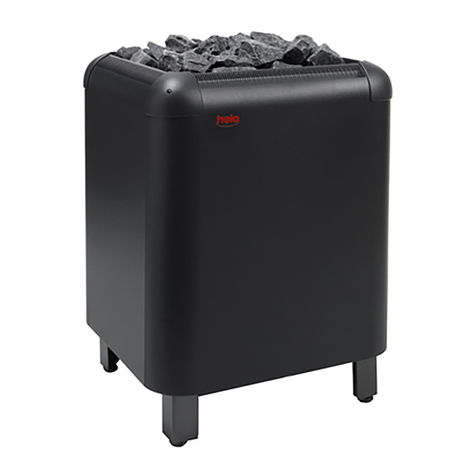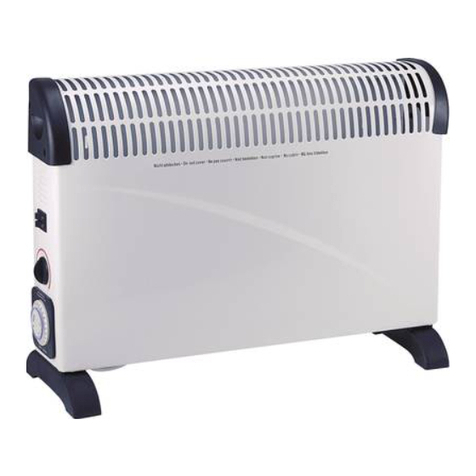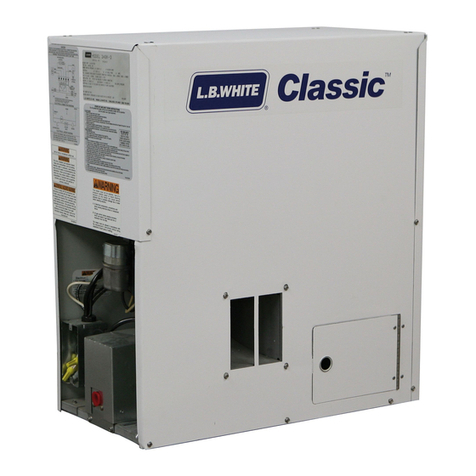Global Naypia HE GPHL**RN Mounting instructions

Naypia HE
Model No. GPHL**RN
HIGH EFFICIE CY LOG EFFECT ROOM HEATER
Installation, Maintenance & User Instructions
Hand these instructions to the user
Model o. GPHL**R is for use on atural Gas (G20) at a supply pressure of
20 mbar in G.B. / I.E.
** Denotes trim & colour variant

CO TE TS
PAGE
Section 1 Information and Requirements
1.0 Appliance information 3
1.1 Conditions of installation 4
1.2 Flue & Chimney Suitability 4
1.3 Shelf position 5
1.4 Hearths 5
1.5 Installation to plastered wall surfaces 5
Section 2 Installation of Fire
2.1 Unpacking the combustion chamber 6
2.2 Preparing the combustion chamber opening (In studded wall) 7
2.3 Preparing the combustion chamber opening (In chimney breast) 8-9
2.4 Securing the fire to the opening 10
2.5 Installation of the gas supply 11
2.6 Fitting the efficiency / flue restrictor baffle 12
2.7 Fitting the batteries to the fire 12
2.8 Removal & re-fitting of the glass frame 13
Section 3 Assembling Fuel Bed and Commissioning
3.1 Fitting the fuel bed logset 14-18
3.2 Making the gas connection & checking for gas tightness 18
3.3 Removal & re-fitting the trim 19
3.4 Lighting the appliance - SIT RC system equipped models 20-25
3.5 Lighting the appliance - Mertik Maxitrol system equipped models 26-30
3.6 Checking for clearance of combustion products 31
Section 4 Maintenance
4.1 Removal of the burner assembly 32
4.2 Removal of the control valve 32-33
4.3 Removal of the ultrasonic reciever 33
4.4 Removal of the pilot assembly 33
4.5 Removal / Replacement of the control board 33
4.6 Removal / Replacement of the handset battery 34
Section 5 User Instructions
5.1 Installation Information 35
5.2 About the Naypia HE room heater 36
5.3 Spillage monitoring system 37
5.4 Lighting the appliance - SIT RC system equipped models 38-43
5.5 Lighting the appliance - Mertik Maxitrol system equipped models 44-48
5.6 Cleaning Instructions 49
5.7 Removal & re-fitting the fuel-bed logset 50-54
5.8 Removal & re-fitting the glass frame 55
5.9 Removal & re-fitting the trim assembly 56
5.10 User replaceable parts 57
5.11 Changing the batteries in the RC handset 57
5.12 Changing the batteries in the fire 57
Model number GPHL**R manufactured by:-
BFM Europe Ltd. Trentham Lakes, Stoke-on-Trent, Staffordshire, ST4 4TJ
2

SECTIO 1
I FORMATIO A D REQUIREME TS
1.0 APPLIA CE I FORMATIO
Main injector : (1 off) Stereomatic Injector Cat 82 – size 380 (NG)
Pilot Type : Copreci ODS 21100 / 162 (SIT RC System)
Copreci ODS 21100 / 141 (Mertik Maxitrol
RC system)
Max. Gross Heat Input : 5.4 kW
Min. Gross Heat Input : 3.0 kW
Gas Rate : 0.512 m3/hr (High)
0.290 m3/hr (Low)
Cold Pressure : G20 20.0+/-1.0 mbar (8.0 +/- 0.4 in w.g.)
Ignition : Integral to gas valve
Electrode Spark Gap : 4.0mm
Packed Weight Combustion Chamber : 48.0 kg
Appliance Efficiency Declaration
The efficiency of this appliance has been measured as specified in BS EN 7977-1
: 2002 and the result is 78%. The gross calorific value of the fuel has been used
for this efficiency calculation. The test data from which it has been calculated has
been certified by GL Industrial Services U Ltd. The efficiency value may be used
in the U Government’s Standard Assessment Procedure (SAP) for energy rating
of dwellings.
Fig. 1 Fig. 2
Top View of Combustion Side View of Combustion
Chamber Chamber
3
797 mm
728 mm
351 mm 515mm
560mm
351mm
385mm
385mm

I STALLATIO REQUIREME TS
1.1 CO DITIO S OF I STALLATIO
It is the law that all gas appliances are installed only by a GAS SAFE Registered
Installer, in accordance with these installation instructions and the Gas Safety
(Installation and Use) Regulations 1998 as amended. Failure to install appliances
correctly could lead to prosecution. It is in your own interest and that of safety to
comply with the law. The installation must also be in accordance with all relevant
parts of the Local and National Building Regulations where appropriate, the
Building Regulations (Scotland Consolidation) issued by the Scottish Development
Department, and all applicable requirements of the following British Standard Code
of Practice.
1. BS 5871 Part 2 Installation of Inset Live Fuel Effect Gas Fires
2. BS 6891 Installation of Gas Pipework
3. BS 5440 Parts 1 & 2 Installation of Flues and Ventilation
4. BS 1251 Open fire place components
5. BS 715 / BS EN 1856-2 Metal flue pipes for gas appliances
6. BS EN 1858 Clay Flue Blocks and Terminals
7. IS 813 : Domestic Gas Installation (Republic of Ireland)
o purpose made additional ventilation is normally required for this
appliance, when installed in G.B. When Installing in I.E. please consult
document I.S. 813 : Domestic Gas Installation, which is issued by the
ational Standards Authority of Ireland. If installing in orthern Ireland,
please consult local building regulations. Any purpose made ventilation
must be checked periodically to ensure that it is free from obstruction.
1.2 FLUE A D CHIM EY SUITABILITY
This appliance is designed for use with conventional brick built or lined chimneys
and fabricated flues and metal flue boxes conforming to BS 715 / BS EN 1856-2.
All flues must conform to the following minimum dimensions.
Minimum diameter of circular flues 125 mm
Minimum effective height of all Class 1 (175mm) flues 3 metres
Minimum effective height of all Class 2 (125mm) flues 4 metres
E SURE THAT IF I STALLI G THIS PRODUCT I TO A BRICK BUILT
CHIM EY, THE CHIM EY HAS BEE FULLY SWEPT PRIOR TO PROCEEDI G
WITH THE I STALLATIO .
Safe clearance of products must always be checked by carrying out a smoke
match test as described in section 3.7
4

1.3 SHELF POSITIO
The fire may be fitted below a combustible shelf providing there is a minimum
distance of 300mm above the top of the fire and the shelf does not project more
than 150mm. If the shelf overhangs more than 150mm the distance between the
fire and the shelf must be increased by 15mm for every 25mm of additional
overhang over 150mm.
1.4 HEARTHS
This appliance does not require the fitting of a hearth that projects in front of it
when installed into a recess in either an existing chimney breast or a studded wall.
The appliance must however stand on a non-combustible base that is a minimum
thickness of 12mm
1.5 I STALLATIO TO PLASTERED WALL SURFACES
If installing to a plastered wall, all material must be removed from the 50mm area
surrounding the combustion chamber opening, and replaced with non-combustible
material, such as marble or granite, to prevent plaster cracking. See Fig. 3 below
Fig. 3
5
Combustion Chamber
Opening in Studded all or
Existing Chimney Breast
750mm
520mm
Minimum 50mm of
material to be removed
all round perimeter of
combustion chamber
and replaced with
marble, granite or other
non-combustible
material to create a
sealing area. Secure
combustion chamber via
four off mounting holes
in mounting frame

SECTIO 2
I STALLATIO OF FIRE
2.1 U PACKI G THE COMBUSTIO CHAMBER
Carefully lift the combustion chamber out of the carton. Remove the loose item
packaging carefully from the pack. Check the contents as listed :-
DO OT U DER A Y CIRCUMSTA CES USE THIS APPLIA CE IF THE
GLASS PA EL IS BROKE OR OT SECURELY FIXED TO THE FIREBOX.
Packing Check List
1 off Combustion Chamber & Glass Frame Assembly
1 off Trim (packed in seperate box)
1 off Boxed ceramic fuel-bed set (packed inside combustion chamber)
1 off Installation / User Instruction Manual
1 off Rubber grommet (to seal inlet aperture used on firebox)
1 off Handset & 1 off 9V Battery or 3 off AAA Batteries (dependent upon RC
system)
1 off Loose Items pack – containing :- 1 off Efficiency Baffle
4 off No. 12 x 40mm Screws
4 off Rawlplugs
4 or 6 off off AA Batteries
(dependent upon RC system)
1 off handset wall bracket
(dependent upon RC system)
IMPORTA T OTE BEFORE PROCEEDI G WITH THE I STALLATIO
This product requires a minimum effective flue height of 4.0 metres of minimum
circular cross-sectional area 125mm. If installing the product into a 225mm x
225mm brick chimney, THE CHIMNEY SOUNDNESS MUST BE CHEC ED BY
TESTING prior to a decision being made on whether the chimney requires lining.
If the flue height is greater than 10 metres on an external wall or 12 metres on an
internal wall then a flue liner must be fitted even if the chimney integrity is ok.
Please check the chimney height and integrity prior to proceeding with the
installation, to establish if a chimney liner is required. Any flue pipe should
conform to BS 715 / BS EN 1856-2 (Metal flue pipes for gas appliances).
When you have decided upon if the product requires the fitting of a flue
liner, proceed with the creation of the correct sized builders opening or
studwork installation of the product as per sections 2.2 or 2.3
6

2.2 PREPARATIO OF THE COMBUSTIO CHAMBER OPE I G
(I TO STUDDED WALL) USI G A 125MM FLUE LI ER.
All combustible parts of the studwork must be set at the distances as shown below
in Fig. 4 & 5. For installation into such applications a flue box with 125mm flue
pipe adaptor is available to purchase as a cost option extra, please order part
number 1125-130260, from your local Global stockist.
7
Minimum 50mm at sides
Minimum 50mm at rear
Combustion Chamber
Dimension “A”
Opening
Width = 750mm
Dim “A”
Dim “B”
Dimension “B”
Opening
Height = 520mm
Dim “C”
Dimension “C”
Opening
Depth = 385mm
Fig. 4
Fig. 5
A minimum clearance of
100mm is required above
the top of the draught
diverter to combustible
surfaces
Minimum 125mm flue liner required
125mm diameter minimum
flue liner required
MINIMUM HEIGHT FROM
FLOOR LEVEL TO
BOTTOM OF OPENING IS
150MM

2.3 PREPARATIO OF THE COMBUSTIO CHAMBER OPE I G
(I TO EXISTI G CHIM EY BREAST)
An opening should be constructed to the following dimensions in the existing
chimney breast. See fig. 6 below
Fig. 6
OTE : Please ensure that access holes are cut into either the sides or area
above the lintel to allow access to the flue pipe connection if using a flue liner.
Such access holes are also advantageous in installations where a flue liner is not
required as they provide access for servicing purposes.
If installing without a flue liner, please ensure that sufficient depth is available in
the opening to collect a minimum volumetric area of 12 litres (0.012m3) of flue
debris. This is achieved by a minimum depth of 385mm, the design of the outer
combustion chamber ensures this depth can be met.
Refer to Fig. 1 on page three for dimensions of the flue outlet.
CHECK A Y LOAD BEARI G STRUCTURAL ITEMS ARE OT
AFFECTED BY THE I STALLATIO OF THE PRODUCT. SEE FIG 6
OVERPAGE.
8
Opening Width = 750mm
Opening Height = 520mm
Minimum Depth 385mm
with or without liner
Lintle must
project 150mm
either side of the
opening if
cutting into an
existing chimney
breast

Fig. 7
The opening needs to be sufficient to accomodate the combustion chamber. To
support the wall above the opening, a suitable lintel must be inserted across the
top of the opening. The lintel could be either pre-cast concrete or steel - Catnic
CN52 or CN 46 could be used, depending upon the inner wall thickness. Before
proceeding with the installation of the fire, an assessment of the area immediately
above the fire is required, see Fig. 7 above. If there is no existing openings within
either triangle, proceed with forming the opening. However, if opening or beams
occur within either triangle, then you should seek specialist advice from a
structural engineer or consider relocating the proposed position of the firebox.
9
400mm interactive area
600mm load triangle
The Interactive Zone -
Openings, beams or joists within
this area need to be assessed.
Load triangle - o beam or
opening permissible within this
area
Lintel
e.g. 750mm x 75mm
Proposed Opening in
Chimney Breast

10
2.4 SECURI G THE FIRE TO THE OPE I G
a) The combustion chamber must be secured to the opening via the four
off screw and rawlplugs provided. Fig. 8 & 9 below shows the hole
centres in the mounting flanges of the combustion chamber.
Fig. 8
b) DO NOT SECURE THE COMBUSTION CHAMBER INTO THE
OPENING AT THIS POINT AS ACCESS WILL STILL BE REQUIRED
TO RUN THE GAS SUPPLY PIPEWOR AS DETAILED IN SECTION
2.5
Fig. 9
371mm
779mm
4 holes in combustion
chamber mounting flange
for securing to the opening

2.5 I STALLATIO OF THE GAS SUPPLY (I TO STUDDED WALL OR
EXISTI G CHIM EY BREAST)
Before installing the combustion chamber, decide from which side or if a rear
connection to the gas supply is required. Plan the pipe run to enter the below the
firebox from the left, right or rear and connect to the inlet elbow. See Fig. 10, 11 &
12 below.
ote : Before breaking into the gas supply a pressure drop test should be
carried out to establish that the existing pipework is sound. Always insert
the grommet into the entry point used (a sharp blow with a hammer or chisel
will be sufficient to knock out the opening selected in the firebox) and with
the grommet fitted cut with a sharp knife to allow the supply pipework to
pass through into the firebox.
11
Combustion Chamber
Gas Supply entering from L/H/S
Combustion Chamber
Gas Supply entering from Rear of Combustion Chamber
Outer
Cavity Wall or
rear face of
studwork
Ensure if bringing gas
supply through side or rear
of a chimney breast that the
pipe is sleeved and sealed
with a suitable flexible, non
setting compound
Fig. 10
Fig. 11
Combustion Chamber
Fig. 12 Gas Supply entering from R/H/S

2.6 FITTI G OF THE EFFICIE CY BAFFLE.
a) The product is supplied with an efficiency baffle to improve the
efficiency of the product when installed into Class 1 flues, of minimum
diameter 175mm / 7” or brick built 225mm x 225mm chimneys. The
minimum effective height of all flues must be 3 metres or above.
b) If the product is to be fitted into a Class 1 flue, it may be desirable to fit
the efficiency baffle.
c) If the product is fitted into a Class 2 flue of diameter 125mm / 5” then
the restrictor baffle must not be fitted. It should also be noted that if
fitting into a 125mm / 5” diameter flue that the minimum effective height
of the flue is 4 metres.
d) To fit the efficiency baffle (supplied in the loose items pack), use the 4
screws supplied to secure the baffle to the spigot on the rear of the
firebox as shown below in Fig. 13
Fig. 13
2.7 FITTI G OF THE BATTERIES
a) The battery pack on SIT equipped models is at the front of the product
in the centre. Fit the 6 off AA batteries supplied.
b) The batteries on the Mertik Maxitrol equipped models are on the left
hand side, in the receiver unit. Slide the cover off and replace with 4 off
AA batteries.
12

2.8 REMOVI G / RE-FITTI G THE GLASS FRAME ASSEMBLY
a) The glass frame is held in position by hooking the top flange over the
combustion chamber opening at the top as shown in Fig. 14 below.
Fig. 14
b) The assembly is then secured to the bottom of the combustion chamber
by the two hinge clamp brackets as shown below in Fig. 15. These
are clamped together to form the seal between the glass frame
assembly and the combustion chamber.
Fig. 15
OTE : Always ensure that a consistent seal between the combustion
chamber and the glass frame is achieved.
Glass Frame Assembly
locates over lip on top of
combustion chamber lid, and
drops onto flange as shown.
To remove, unclip base clips
as shown in Fig. 15 and lift
clear.
denotes correct
final position of
glass frame.
Combustion
Chamber
13

SECTIO 3
I STALLATIO OF FIRE
3.1 FITTI G THE FUEL-BED LOGSET
a) The gravel material should then be first layed around the base of the
combustion chamber as shown below in Fig. 16, leaving the rear
section as shown to allow the fitting of Log “A”
Fig. 16
b) Place the largest Log “A” centrally onto the fuel-bed support behind the
burner flame strip. Ensure that the fuel-bed Log “A” is located centrally
in the firebox, and that the front edge is parallel with the rear face of the
burner flame strip as shown below in Fig. 17.
Fig. 17
Fuel-bed
Log “A” to be
fitted behind
burner flame
strip
14
A

c) Fit Log “B” into position on left hand side of the fuel-bed base log “A”as
shown below in Fig. 18, using the groove in Log “A” as a guide for
placement.
Fig. 18
d) Fit Log “C” into position on left hand side of the fuel-bed base log “A”as
shown below in Fig. 19, using the groove in Log “A” as a guide for
placement.
Fig. 19
15
B
C

d) Fit Log “D” into position on left hand side of the fuel-bed base log “A”as
shown below in Fig. 20, using the groove in Log “A” as a guide for
placement.
Fig. 20
e) Fit Log “E” into position at centre of the fuel-bed base log “A”as
shown below in Fig. 21, using the groove in the centre of Log “A” as a
guide for placement.
Fig. 21
16
D
E

f) Fit Log “F” into position at right hand side of centre of the fuel-bed base
log “A”as shown below in Fig. 22, using the groove in Log “A” as a
guide for placement.
Fig. 22
g) Fit Log “G” into position at right hand side of the fuel-bed base log “A”as
shown below in Fig. 23, using the raised section in the base log as a
guide for position.
Fig. 23
IMPORTA T OTE
HAVI G FITTED THE GRAVEL MATERIAL I THE BASE OF THE
COMBUSTIO CHAMBER, E SURE THAT O E OF IT IS O THE BUR ER
FLAME STRIP OR I THE PILOT ASSEMBLY. IF MATERIAL IS OBSERVED
VISUALLY O THESE COMPO E TS, REMOVE THE FUEL-BED LOGSET,
REMOVE THE GRAVEL MATERIAL FROM THE BUR ER A D OR PILOT A D
RE-FIT THE LOGS AS DETAILED I SECTIO 3.1 ABOVE.
17
F
G

Warning : Use only the logs supplied with the fire. When replacing the
logs remove the old logs and discard them. Fit a complete set of logs of the
correct type. Do not fit additional logs or any logs other than a genuine
replacement set.
This appliance uses fuel effect pieces containing Refractory Ceramic Fibres
(R.C.F.), which are man-made vitreous silicate fibres. Excessive exposure to
these materials may cause temporary irritation to eyes, skin and respiratory
tract. Consequently, it makes sense to take care when handling these arti-
cles to ensure that the release of dust is kept to a minimum. To ensure that
the release of fibres from these R.C.F. articles is kept to a minimum, during
installation & servicing we recommend that you use a HEPA filtered vacuum
to remove any dust and soot accumulated in and around the fire, before and
after working on the fire. When replacing these articles we recommend that
the replaced items are not broken up, but are sealed within a heavy duty
polythene bag, clearly labelled as “RCF waste”. This is not classified as
“hazardous waste” and may be disposed of at a tipping site licensed for the
disposal of industrial waste. Protective clothing is not required when
handling these arrticles, but we do recommend you follow the normal
hygiene rules of not smoking, eating or drinking in the work area, and
always wash your hands before eating or
drinking.
This appliance does not contain any component manufactured from
asbestos or asbestos related products.
Refit the glass frame as detailed in section 2.7, then light the appliance as detailed
in section 3.4 / 3.5 as applicable.
3.2 MAKI G THE GAS CO ECTIO & CHECKI G FOR GAS
TIGHT ESS
a) Before making the final gas connection, thoroughly purge the gas
supply pipework to remove all foreign matter, otherwise serious
damage may be caused to the gas control valve on the fire.
Failure to purge the gas supply will invalidate the guarantee.
b) The gas connection should be made to the appliance inlet elbow to
using 8mm rigid tubing.
c) Remove the pressure test point screw from the inlet elbow and fit a
manometer.
d) Turn on the main gas supply and carry out a gas tightness test.
18

3.3 REMOVAL & RE-FITTI G OF THE TRIM ASSEMBLY
a) The trim is attached to the lid of the combustion chamber by
hooking the retaining lugs on the rear face of the trim assembly into the
slots in the front face top of the combustion chamber lid as shown
below in Fig. 24.
Fig. 24
b) Ensure the retaining lugs are correctly engaged into the slots and not
supported by the heat shield. When the trim is correctly located it will
be fitted flush to the wall.
c) If fitting the fascia with the optional stainless steel overlay this is
secured to the front face of the fascia with 4 off 6mm magnets.
Retaining lips on rear
face of trim hook into
the slots on the
combustion
19

3.4 LIGHTI G THE APPLIA CE
Before attempting to light the appliance, please determine which remote
control system the product is fitted with. To determine this, check the
handset designs as shown below and follow the instructions on the
proceeding pages as necessary.
3.4.1 If fitted with the S.I.T. ACS2T System, the handset as shown below in
Fig. 25 will have been supplied. Please refer to section 3.4.3 to section
3.4.7.
Fig. 25
3.4.2 If fitted with the Mertik Maxitrol GV60 system, the handset as shown
below in Fig. 26 will have been supplied.Please refer to section 3.5.1 to
section 3.5.6
Fig. 26
20
Table of contents
Other Global Heater manuals
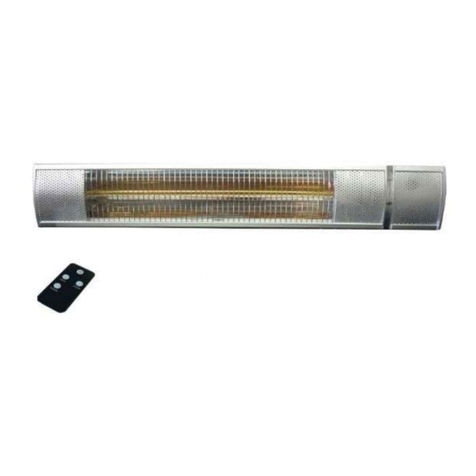
Global
Global INFRA2000+ PRO User manual

Global
Global 246097 User manual
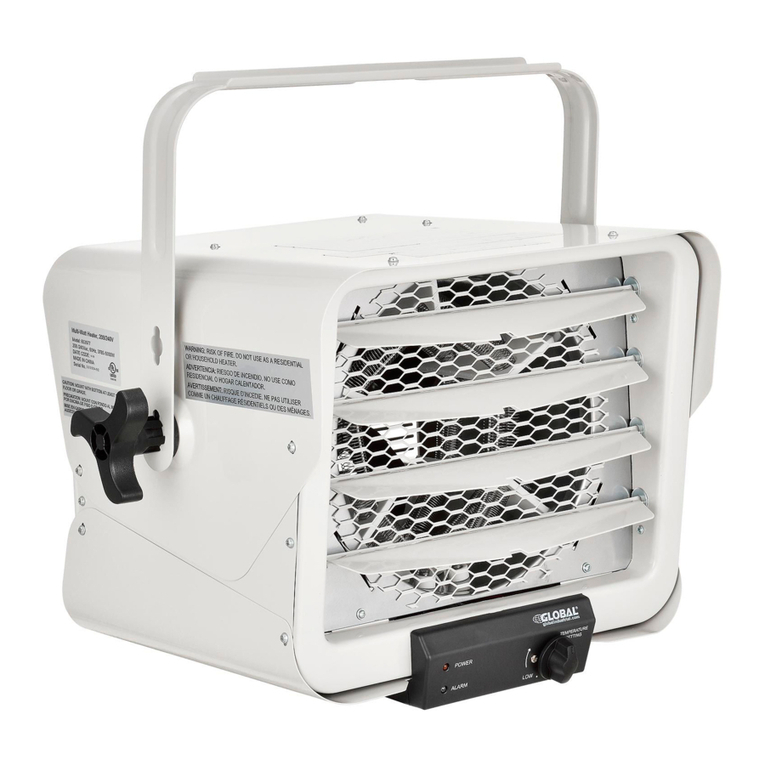
Global
Global 653577 User manual

Global
Global SUNPOWER 1150 W User manual
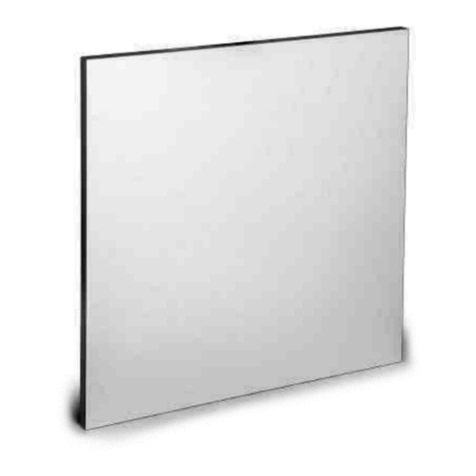
Global
Global SUNPOWER 750 W User manual

Global
Global 653557 User manual
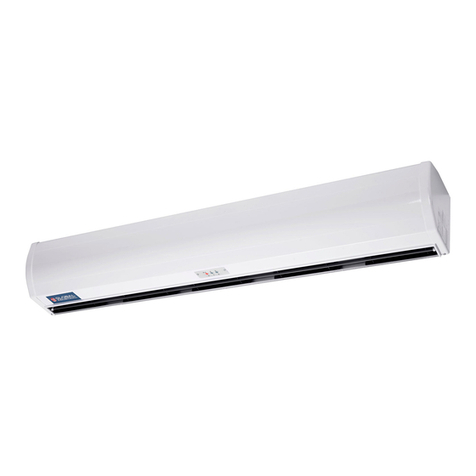
Global
Global 246610 User manual
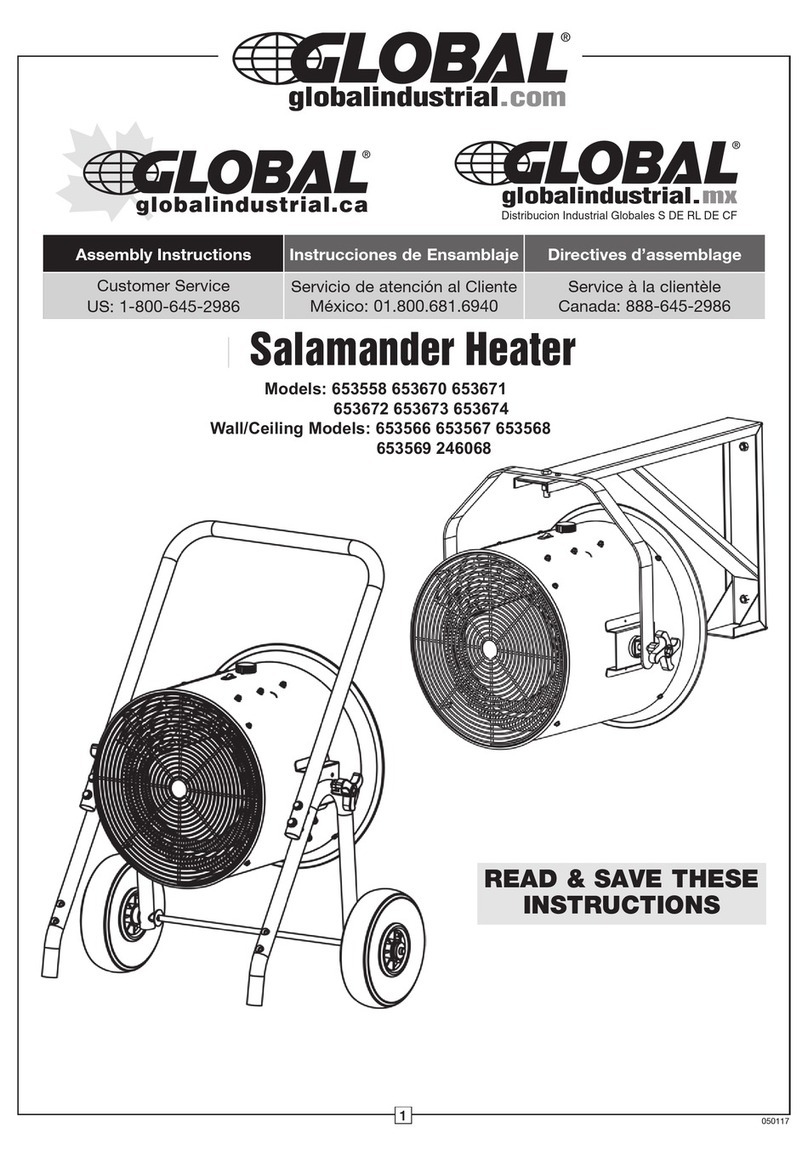
Global
Global 653558 User manual
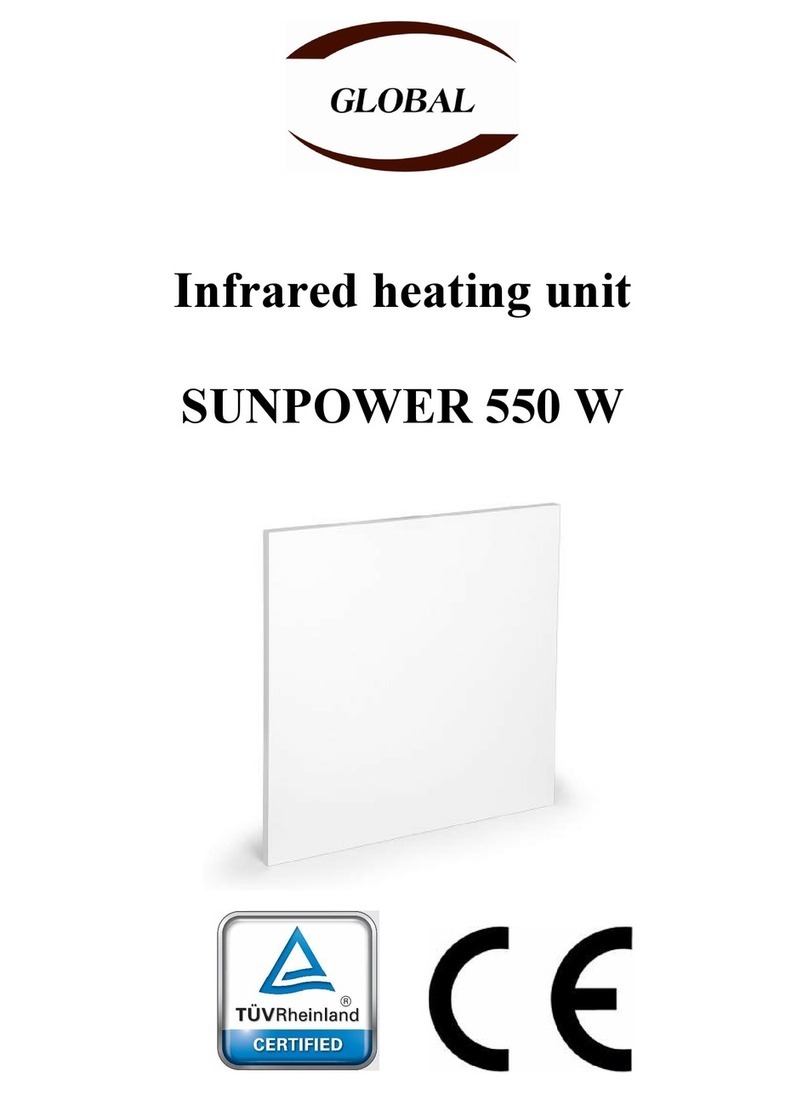
Global
Global SUNPOWER 550 W User manual
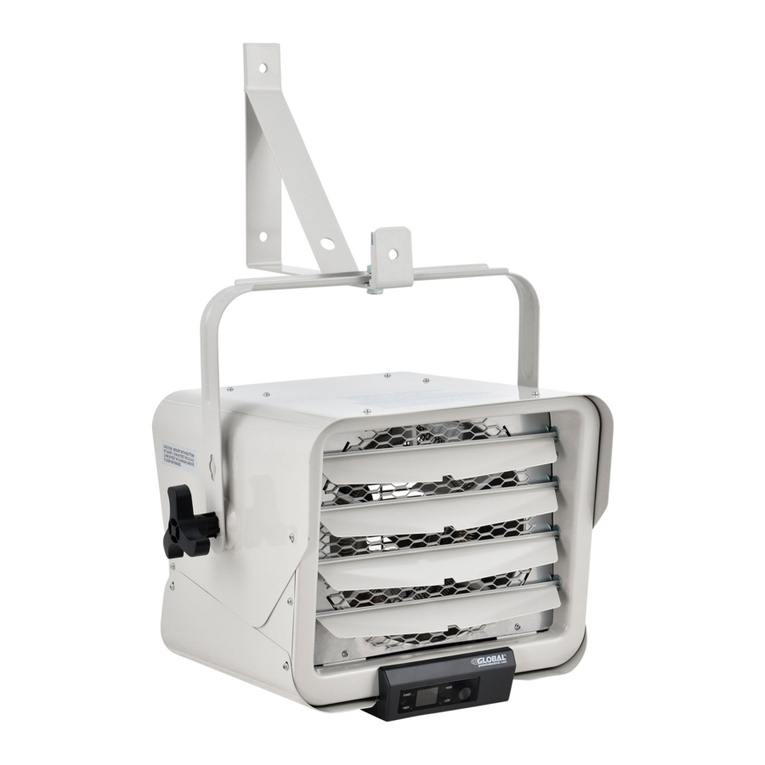
Global
Global 246726 User manual
